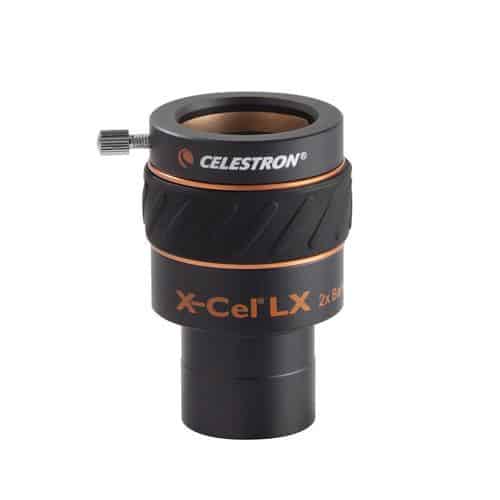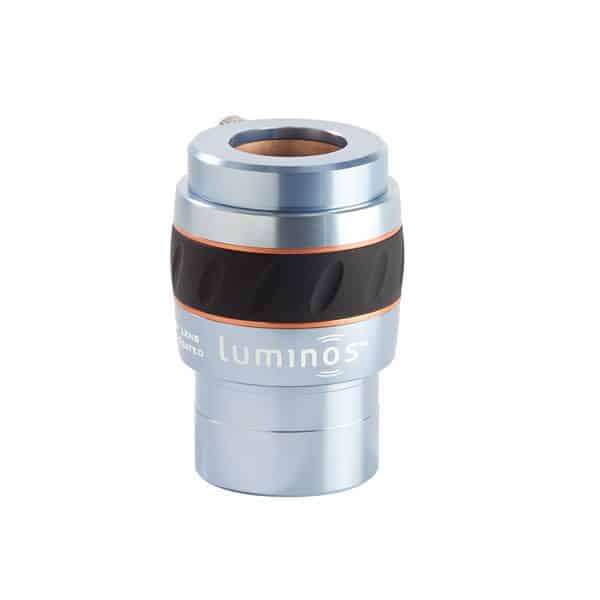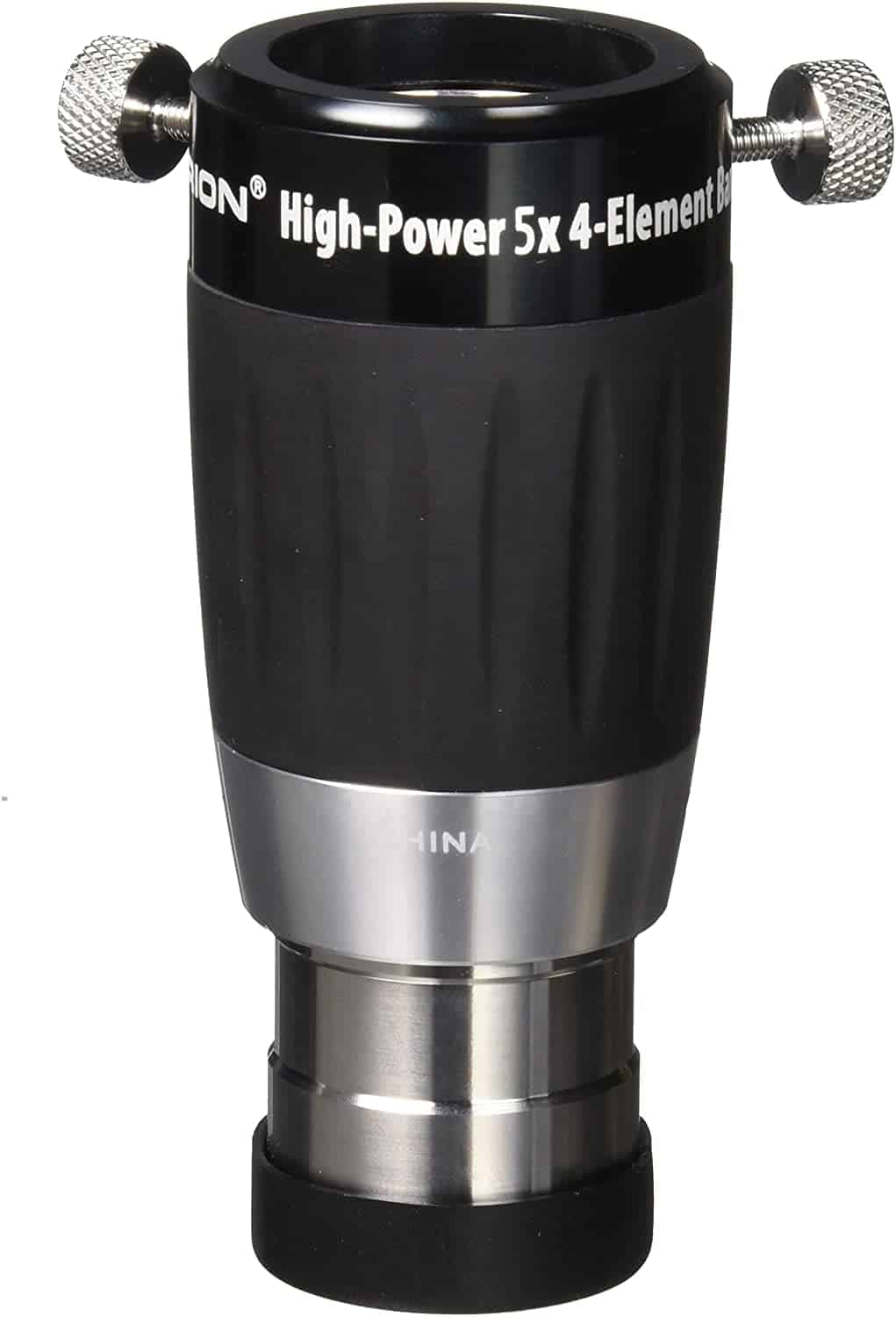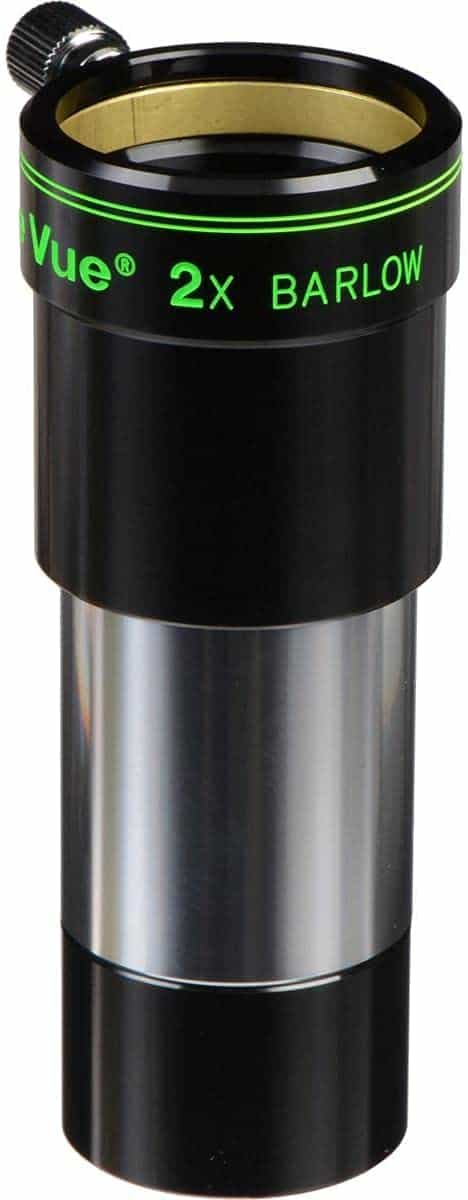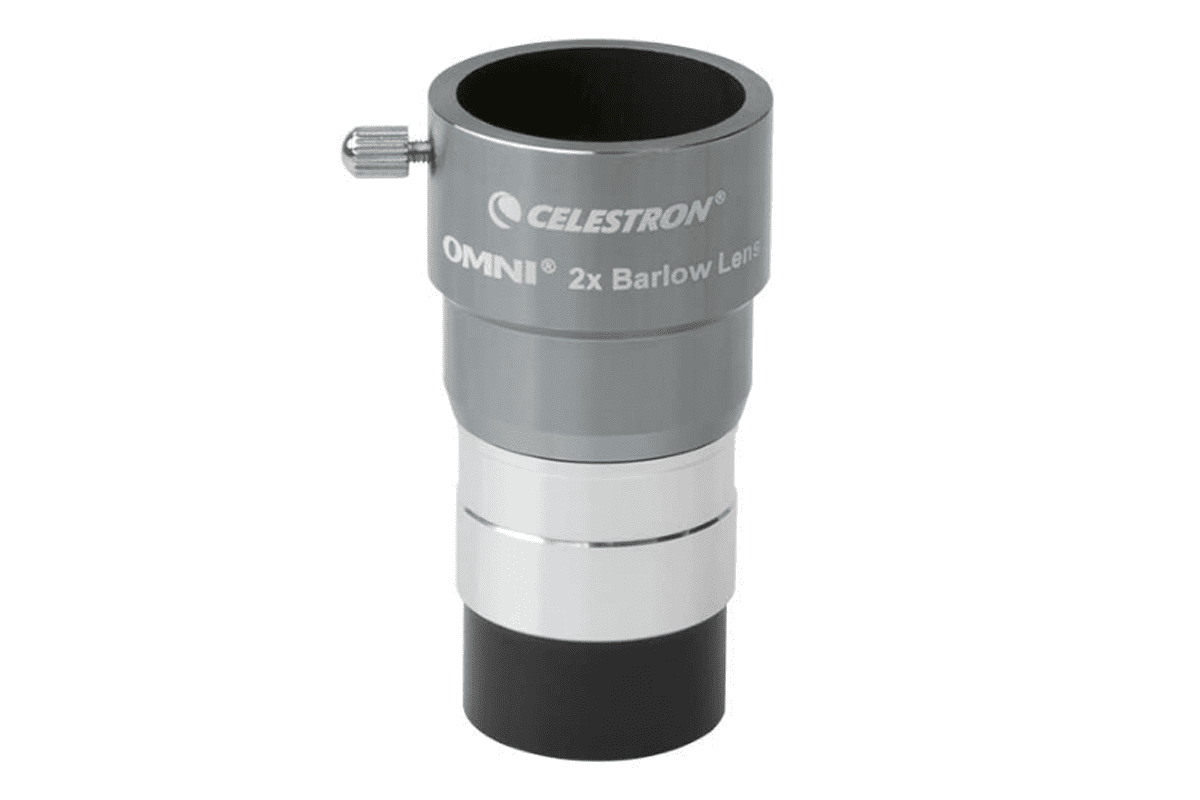Astronomy is a truly wonderful hobby. Whether you’re an adult fascinated by the night sky and you’re looking for a fun pastime to engage in, or you are the parent of a budding young scientist who loves looking at the stars, purchasing a telescope is a great place to start.
However, once you have purchased a telescope and you’ve mastered using it, you might be wondering, what next? Well, purchasing a Barlow lens is a great way to increase the magnification of your telescope, allowing you to see smaller celestial bodies in greater detail.
Celestron 93529 X-Cel LX 1.24-Inch 2x Barlow Lens
FEATURES: Compatible with 1.25" diameter focuser barrels, 2x magnification, and Multi-coated Celestron X-Cel 2x Barlow Lens
BENEFITS
- Compatible with any 1.25” eyepiece
- 2x Lens with 3-element apochromatic, fully coated optics provides bright and crisp images
- Sturdy and good quality design
Celestron 2.5X Luminos Barlow Lens - 2" - 93436
FEATURES: Compatible with 1.25" or 2" diameter focuser barrels, 2.5x magnification, and Multi-coated Celestron Luminos 2.5x Barlow lens
BENEFITS
- Compatible with any 1.25” or 2" eyepiece
- 2.5x Lens with fully multi-coated 4 element optics that provide sharp and color accurate images
- Large thumbscrews and rubber grip for easy handling with gloves
Orion 8715 High-Power 1.25-Inch 5x 4-Element Barlow Lens
FEATURES: Compatible with 1.25”, 5x Magnification, and Multi-coated 5x Element Barlow lens,
BENEFITS
- Compatible with any 1.25” eyepiece
- 5x Lens with fully multi-coated 4 element optics that avoids optic aberrations
- Silicone grip that provides easy and non-slip handling
FEATURES: Compatible with 1.25” diameter focuser barrels, 2x Magnification, and Multi-coated Tele Vue 2x Barlow lens
BENEFITS
- Compatible with any 1.25” eyepiece
- 2x Barlow lens has multi-coated high index glasses provides very high-quality images.
- Sturdy and superior build with the best optics in the market
Celestron Omni Series 1.25" 2x Barlow Lens - 93326
FEATURES: Compatible with 1.25” diameter focuser barrels, 2x Magnification, and Multi-coated Omni 2X Barlow Lens
BENEFITS
- Compatible with any 1.25” eyepiece
- 2x Barlow lens has multi-coated optics with blackened edges
- Affordable price point
Sounds amazing, right? Well, if you’re interested, we’ve listed the five best Barlow lenses available today. Each one has been hand-selected according to its quality, magnification, versatility, and price. Whatever your budget is, we’ve got you covered!
We are also very aware of how inaccessible astronomy can feel. To help you understand exactly what you need from a Barlow lens, we’ve created a handy buyer’s guide to help you make the most informed purchase possible. Check it all out below!
We had to kick things off with the Celestron X-cel LX Barlow Lens. In our opinion, this is the best all-around Barlow lens available today. If you’re looking for a piece of quality equipment with excellent features, wonderful optics, and an affordable price tag, check this one out!
This Barlow Lens is of excellent build quality. It is sturdy, looks eye-catching, and features a rubber grip that will help prevent any accidental drops. As such, this is ideal for anyone who enjoys taking their telescope out and about with them.
This lens works to double the magnification of any 1.25 eyepiece. As 1.25 is a very standard size for eyepieces, this means that you should be able to use most (if not all) of your eyepieces with this Barlow lens.
However, if 2x magnification isn’t enough for you, this model also comes in 3x magnification.
The Celestron X-Cel LX Barlow Lens has 3-element apochromatic, fully multi-coated optics that offer incredibly bright and sharp images of the night sky. In fact, you shouldn’t experience any color aberrations with this Barlow lens.
This Barlow Lens is responsible for some of the clearest Moon and planet photos you’ll find online (apart from NASA’s, obviously).
As such, if you’re looking for a Barlow Lens that can really take your hobby to the next level, you should definitely check this one out.
When we tested this Barlow Lens, we really appreciated the particularly high-quality construction. You can tell that this lens will last for a very long time as long as it is taken care of. We cannot recommend it enough!
Pros
- Good build quality – this lens is particularly sturdy.
- Works with any 1.25 Eyepiece – makes this a versatile lens.
- 3-element apochromatic, fully coated optics – provide bright and crisp images.
Cons
- Design – if you don’t have other Celestron equipment, this lens may look out of place.
FEATURES: Compatible with 1.25" or 2" diameter focuser barrels, 2.5x magnification, and Multi-coated Celestron Luminos 2.5x Barlow lens
BENEFITS
- Compatible with any 1.25” or 2" eyepiece
- 2.5x Lens with fully multi-coated 4 element optics that provide sharp and color accurate images
- Large thumbscrews and rubber grip for easy handling with gloves
If you love Celestron but you’re looking for a Barlow Lens with a bit more power and flexibility than the one above, you need to take a look at the Celestron 93436 Luminous 2-Inch 2.5x Barlow Lens.
This lens increases the magnification of any 2 or 1.25 eyepiece by two and a half times. As such, this Barlow lens is particularly versatile and should be usable with most, if not all, of your Eyepieces.
It also boasts particularly high-quality, 4-element optics. These produce a flat field for sharp images that are certain to be free of extraneous color. As such, this Barlow lens is ideal for anyone who wants to up their game and start viewing super high-quality images.
This lens has a brass compression ring that holds the eyepieces firmly in place. It also boasts large thumbscrews that are easy to use (even whilst wearing gloves), and a rubber grip.
As such, this lens is a good option for people who want to take their telescope out and about with them,
As you might have guessed (considering the top two spots on this list have been taken up by Celestron), Celestron is a very well-trusted company. They consistently produce high-quality telescope gear, and every product is of the highest standard.
When we tested this Barlow lens, we really liked the extra power of the 2.5x magnification. The optics produced wonderfully sharp and bright images, and it felt sturdy enough to withstand travel. What more could you ask for?
Pros
- Works with 2 and 1.25 Eyepieces – makes this a versatile option.
- High-quality, 4-element optics – provides very sharp and bright images.
- Large thumbscrews – can be used wearing gloves.
- Rubber grip – makes this lens easy to grip, even whilst wearing gloves.
Cons
- Design – may look out of place if you don’t have other Celestron equipment.
If you’re looking for a high magnification Barlow lens, look no further than the Orion 8715 High-Power 1.25-Inch 5x Element Barlow Lens. This lens is perfect for those of you who are just oh-so desperate to see celestial objects in as high detail as possible.
Using this 5x Barlow lens is an excellent viewing experience. If you’re lucky enough to have a telescope with significant power, with this lens, you will be able to see details that you would otherwise struggle to identify.
If you’re looking to obtain very high-power views of the moon and planets, this lens is the one for you. The 4-element lens design preserves the optical quality of the telescope and eyepieces for perfectly sharp and bright views.
These features also ensure that this lens will completely avoid optic aberrations and will maintain colors. However, it is worth noting that this lens is particularly expensive, and probably isn’t worth the money unless you have a telescope with an aperture of at least 120mm.
The outer design of this Barlow lens is great. It features a large silicone section that provides a great grip.
It also has a simple, classic, and sturdy design that will look great with most telescopes and will hold up well if you travel with your telescope frequently.
When we tested this Barlow lens, we were taken aback by the quality of the view. If you’re super keen to see celestial bodies in greater detail, we cannot recommend this Barlow lens enough! However, it is worth noting that this lens is likely to be unnecessary for a beginner.
Pros
- 5x magnification – ideal for viewing the moon and planets in greater detail.
- 4-element lens design – the images are crisp and clear.
- Silicone grip – helps to avoid accidents.
Cons
- Price – this lens is more expensive than others on this list.
FEATURES: Compatible with 1.25” diameter focuser barrels, 2x Magnification, and Multi-coated Tele Vue 2x Barlow lens
BENEFITS
- Compatible with any 1.25” eyepiece
- 2x Barlow lens has multi-coated high index glasses provides very high-quality images.
- Sturdy and superior build with the best optics in the market
If you’re feeling ready to really up your game, and you fancy investing in a quality piece of kit, you need to check out the Tele Vue 2x Barlow lens. Tele Vue is the most premium brand of its kind, so its products really are the best of the best.
As Tele Vue points out, properly designed Barlows should do three things well. First, they should amplify the power of your telescope whilst retaining the eyepiece’s eye relief.
Second, they should slow the telescope f-ratio, which, in turn, improves the sharpness of the eyepiece. Finally, the lens should compensate for aberrations of the eyepiece.
This Barlow lens does all that very well, and more! It has multi-coated high-index glasses to ensure optimum aberration correction, incredible contrast, and essentially no loss of light. As such, it provides very high-quality images.
This Tele Vue 2x Barlow lens is best suited to people who already own premium Tele Vue eyepieces and a moderately powerful telescope. Unfortunately, pairing this Barlow lens with low-quality equipment will not do it justice.
However, if you do pair it with the proper equipment, this Barlow lens will produce wonderful views. If you are looking for the best equipment and you have a larger budget, you will not regret purchasing the Tele Vue 2x Barlow lens.
When we tested this lens, we found it to be of superior quality, not just in terms of the quality of the image produced, but also in terms of the design.
It is a simple, sturdy, and well-built piece of kit. However, it definitely isn’t for beginners, and it does have a higher price than other Barlow lenses.
Pros
- Tele Vue – produces premium quality pieces of kit.
- Multi-coated high index classes – provide excellent quality images with no color aberration.
- Best optics available today – mean this Barlow lens really is as good as it gets.
Cons
- Price – this is more expensive than others on this list.
- Only for people who own Tele Vue products – this lens works best with Tele Vue products and telescopes with high power.
Finally, we just had to sneak in another Celestron product into this list. The Celestron OMNI 2x Barlow Lens is a great option if you want a good-quality, affordable, Barlow lens that is well-suited to hobbyists.
This lens will work with any 1.25 eyepieces, regardless of the telescope or brand of eyepiece you have. This makes it a particularly versatile piece of equipment that is particularly well suited to people on a budget.
In fact, this lens has fully multi-coated optics with blackened edges. This ensures that the light is transmitted from the eyepiece to your eye without creating additional reflection and aberrations.
This feature is particularly great considering the price of this lens.
Similarly, this lens will also maintain the eyepiece eye relief and provide 2x magnification for your eyepieces.
As such, the Celestron OMNI 2x Barlow Lens competes with models that are over double the price!
The overall design of this lens is simple and sturdy. It is worth mentioning that there is no silicone grip, so it is important to handle this lens with care. However, if you’re a beginner and don’t plan on traveling with your telescope much, this shouldn’t be a problem.
As you might have already guessed, we love pretty much every product that Celestron produces, and this Barlow lens is absolutely no exception. Considering the price, we were taken aback by the features of this model. This is definitely an ideal Barlow lens for beginners.
Pros
- Compatible with any 1.25 eyepiece – makes this a versatile lens.
- Multi-coated optics with blackened edges – prevents reflections and aberrations.
- Price – very affordable.
Cons
- No silicone grip – needs to be handled with care.
Buyer’s Guide
Astronomy can be a wonderful hobby. What could be better than spending your evenings exploring the night sky, viewing celestial bodies using a telescope that would otherwise be impossible to see with the naked eye?
However, we are very aware of how inaccessible astronomy can feel at times.
You need a fair amount of equipment if you want to see such celestial objects in great detail. In addition to a good-quality telescope, you will likely also require a Barlow lens.
Barlow lenses can really range in price and quality, and as such, purchasing the right one for you and your needs can feel a little tricky (or even downright impossible). It can be even more intimidating if you’re a total beginner, as these purchases are often surrounded by a huge amount of scientific jargon.
To help you along the way, we’ve created a handy buyer’s guide. This consists of everything you need to know and consider before purchasing a Barlow lens.
From magnification power to optics correction and everything in between, we cover it here. Check it out below.
What Is A Barlow Lens?
If you’ve managed to make your way to this article, it’s likely that you know what a Barlow lens is. However, we thought we would cover the basics before delving into the details to ensure that we’re all on the same page.
A Barlow lens is an optical tube containing lens elements that diverge the light passing through them. Even though that might sound complicated, we promise it isn’t. Essentially, a Barlow lens adds a second lot of magnification to your eyepiece whilst maintaining eye relief.
Choosing The Best Barlow Lens for You
Now we’ve covered the basics, and we can really get into the juicy stuff.
The type of Barlow lens that is best suited to you will completely depend on your experience and desires. Below, we’ve listed the most important aspects of a Barlow lens that you need to understand so that you can be a better judge of what Barlow lens is best suited for you.
Magnification Power
Barlow lenses tend to come in magnifications of 2x, 3x, and 5x. For most hobbyists, a 2x Barlow lens is more than enough to achieve the level of detail you want.
In fact, if you own a smaller telescope, a 3x or 5x Barlow lens is likely to considerably affect the viewing quality due to too much magnification power.
As such, if you are a beginner or casual astronomer who doesn’t own a particularly high-power telescope or super-quality eyepieces, we recommend purchasing a 2x Barlow lens. This will give you everything you need without compromising on quality.
On the other hand, if you have a larger, more powerful telescope that draws in a lot of light, feel free to purchase a Barlow lens with higher magnification. These will really increase the magnification of your eyepiece, so you will likely be able to see objects like the moon and planets in great detail.
It is also important to consider the maximum magnification of your telescope before purchasing a Barlow lens of particular magnification.
Telescopes have a limit to what they can do, and if you combine a highly magnifying Barlow lens with a particularly small eyepiece, your telescope is likely to be unable to produce clear views.
As such, before purchasing a Barlow lens, we recommend doing a little bit of math to figure out the maximum useful magnification of your telescope. If you’re not sure how to do this, don’t worry! Check out the super simple explanation below.
Maximum Useful Magnification
Maximum useful magnification is pretty much what it says on the tin- the maximum limit of magnification that your telescope can support given its aperture and focal length.
If you extend beyond this maximum, the images produced will be very distorted and unclear.
To figure out the maximum useful magnification of your telescope, you simply need to multiply the aperture (inches) by 50. As an example, if your telescope has an aperture of 130mm, you first need to convert this into inches.
A quick Google search will tell you that 130mm is 5.1 inches (or you could do the conversion 130/25.4). Then, you do the multiplication 5.1 x 50. This equals 255. So the maximum useful magnification of this particular telescope is 255x.
Now, you can take a look at your eyepieces to see how much magnification you get from those. To do this, you can either use this handy calculator, or if you’re a fan doing the math by hand, you can use this formula:
Telescope Focal Length / Eyepiece Focal Length
Now, consider the imaginary telescope we discussed above. If that telescope has a focal length of 1000mm, the maximum focal length for an eyepiece would be worked out as follows:
1000 / Eyepiece Focal Length = 255
1000 / 255 = Eyepiece Focal Length = 3.9
So, the maximum focal length for an eyepiece will be roughly 3.5 mm. As such, if you plan to purchase a Barlow lens with 2x magnification, you will need an eyepiece with at least 7mm focal length. If it is smaller than this, your image won’t be improved by the Barlow lens.
We know that this looks like quite a fuss, but we really enjoy this aspect of astronomy. Working out exactly what products will work best for you really is a part of the fun! If your child is a keen budding scientist, getting them involved is a great way to nurture their enthusiasm.
Eyepiece Compatibility
You will have noticed that in the reviews above, we discuss what eyepieces each Barlow lens will be compatible with. Before purchasing a Barlow lens, it is incredibly important to know whether it will work with your current eyepieces.
You can get either 1.25 or 2 Barlow lenses. Most (if not all) Barlow lenses tend to be compatible with 1.25 eyepieces, as this is the most common type. However, if the Barlow lens you’re looking at has been made with a specific reason in mind, this might not be the case.
Similarly, if you need a Barlow lens that is compatible with 2 eyepieces, it is very important that you check the manufacturer’s details to ensure compatibility.
Most of the Barlow lenses listed above are compatible with 1.25 eyepieces. However, the Celestron 2.5-Inch Barlow Lens is compatible with both 1.25 eyepieces and 2 eyepieces.
Image Quality
It is also important to mention image quality. Barlow lenses should feature multiple coatings and a blackened interior. This is because these features work to significantly reduce the possibility of light distortions and color aberrations.
Unfortunately, whilst most high-quality Barlow lenses will include such features, some of the more budget-friendly options will not.
As such, if you’re on a budget, we recommend purchasing a Barlow lens from a very reputable company, such as Celestron.
The Barlow lenses that Celestron produces should never allow for distortions such as color aberrations. Regardless of the price, they should produce a clear view. We recommend checking out the Celestron OMNI Barlow Lens (listed above) if you are on a budget.
How To Use A Barlow Lens
Finally, we thought we’d finish things off by discussing how exactly you should use a Barlow lens. Before following our instructions, we always recommend checking the manufacturer’s instructions, as how to properly use a Barlow lens can differ between products.
However, generally speaking, to use a Barlow lens, you usually need to remove the eyepiece from your telescope. Following, you connect the eyepiece you want to use to your Barlow lens.
Finally, you can attach the rube of the Barlow lens to your telescope, and voila! You’re ready to see some celestial objects up close and personal (well, as close as possible).
Frequently Asked Questions
Is A Barlow Lens Worth It?
This depends. Barlow lenses are usually a cheaper alternative than purchasing a super expensive, short focal length eyepiece. However, if you’re not trying to see small celestial objects, neither of these things will be necessary.
Can I Use Multiple Barlow Senses Together?
Yes, you absolutely can! Using multiple Barlow lenses is called stacking, and it is actually quite a common practice. People do this to increase the focal length by multiplying the individual focal lengths of each lens.
Can You See Galaxies Using A Telescope?
Galaxies are some of the most distant celestial objects that we can observe. As such, even the brightest galaxies aren’t really visible. With a 4-inch telescope, you might see the gore of a bright galaxy.

